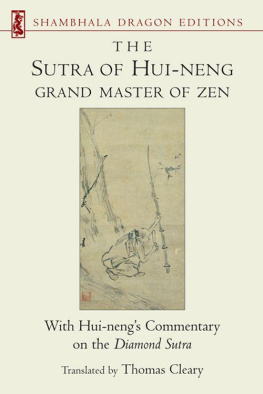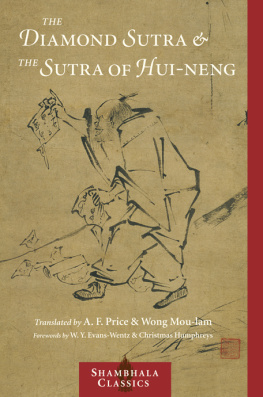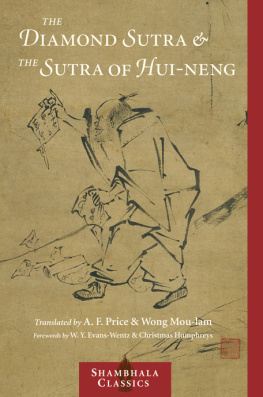
A Commentary on the Sixth Patriarchs
Platform Stra

EXPLORE THE SEMINAL PLATFORM STRA, WITH ONE OF THE GREATEST LIVING ZEN MASTERS AS A GUIDE.
A lodestone of Zen Buddhism, the Platform Stra presents the life, work, and wisdom of En, or Huineng, the fascinating seventh-century Sixth Patriarch of Chinese Zen. He was an illiterate woodcutter who famously attained enlightenment after only hearing a single line of the Diamond Stra and who went on to decisively upstage senior monks with a poem that demonstrated the depth and clarity of his insight. His example has demonstrated to generations of students and spiritual seekers worldwide that enlightenment is attainable regardless of education or social standing. His exhortations to directly perceive ones true nature, right here and now, still reverberate in contemporary Zen.
Shodo Harada Rshis fresh reading of the Platform Stra offers both the history behind the work and the lived experience of its wisdom. In a plain-English, conversational voice, Shodo Harada brings the stra to life for his students, discussing and explaining its central points chapter by chapter and illustrating it with his own beautiful calligraphy. This is an essential Buddhist text brought to life.
For Jundo, whose vision for this book has made it a reality
List of Calligraphies
Do not think of good, do not think of evil
At this very moment, what is hidden is within yourself
Without thought, awareness is true
With thought, awareness becomes false
Externally, for the mind not to arouse thoughts with regard to all good and bad situations is called seated
Internally, to see the unmoving self-nature is called meditation
Preface
T he material in this book comes from talks that Shodo Harada gave during semiannual meditation retreats at Tahoma monastery on Whidbey Island, Washington, between 2000 and 2007. Priscilla Daichi Storandts translations during the original talks were transcribed and edited by Mitra Bishop, with assistance from Judy Myokyo Skenazy and Alan Gensho Florence, and then prepared in a limited edition of hand-bound volumes by Alan Gensho Florence. Shodo Harada presented these hand-bound volumes to his students and others.
At the end of that first set of lectures in September 2000, my late husband, Tim Jundo Williams, impressed upon Shodo Harada the value of the talks and encouraged him to gather them as a book once the series was complete. Jundo lived to see the third of the hand-bound volumes completed in the fall of 2011 but died a few months later, just as we had begun the process of editing the material for book publication.
More than one hundred hours of talks over the course of eight years necessarily contained much repetition and far more material than appears in this book. For example, in every talk Shodo Harada stresses the importance of zazen and repeats basic instructions. In order to retain the emphasis on zazen while avoiding repetitions that would seem onerous to a book reader, I have removed these repetitions. Because the talks were attended by people who were not sesshin participants and often had not heard the previous talks, nearly every talk began with a summary of what was said in the previous talks. Likewise, many stories and quotes recurred frequently over the years, and I have included them where they seem to best fit the flow of the stra.
This book is not a line-by-line analysis of the Sixth Patriarchs Platform Stra but a parallel text, to be read alongside the stra itself. The chapters of this book mirror the chapters of the stra in title and in organization. In the original lectures, Shodo Harada read a passage from the stra and then talked about it. In the interests of space, herein the passages themselves have been removed and what remains is the discussion about them. The majority of the quoted material represents Shodo Haradas own paraphrases of the dialogue in the stra. With the exception of the poems presented by Jinsh and En, the few passages that are direct quotes are taken from John R. McRaes The Platform Sutra of the Sixth Patriarch (Berkeley, CA: Numata Center for Buddhist Translation and Research, 2000). To read McRaes translation in its entirety, courtesy of BDK America. The poem translations are from Wong Mou-lams The Sutra of Wei Lang or Hui Neng (Buddhist Association of the United States, 1998). In the text these direct quotations are indicated by the bold font.
This publication is truly a group effort. Josh Bartok at Wisdom Publications shared Jundos vision for this book and encouraged me to see it through to completion. Andy Francis, also at Wisdom, was unfailingly helpful, as was Laura Cunningham, who provided superb editing and saw the book through the actual publication process. Thomas Yh Kirchner reviewed an earlier version of the glossary and the captions for this book, as well as providing advice along the way for the hand-bound volumes. Priscilla Daichi Storandt was always available to answer questions. Mitra Bishop carefully read the manuscript and offered suggestions. Alan Gensho Florence oversaw the preparation of the calligraphic illustrations. I hope that Shodo Haradas wisdom and deep understanding shine through in spite of any errors I might have introduced during this process.
Jane Shotaku Lago
Introduction
T he Dharma Jewel ofthe Platform Stra of the Sixth Patriarch, first recorded around 700 C.E. by the Sixth Patriarchs disciple Hkai, exists in many versions. Lacking todays technology for printing and sharing documents, those who wanted copies of the patriarchs teachings had to write them manually, often copying only the sections they found useful. The variation thought to be the most complete was found in 1907 by the Hungarian-British archaeologist Aurel Stein in the Mogao Caves, or the Caves of the Thousand Buddhas, an ancient site in China. The origins of the text are obscure and the subject of much scholarly debate.
En, or Huineng, as he is known in China, was the sixth successor to the Dharma after Bodhidharma. The stra is called the Platform Stra because it was given on the same platform on which the Sixth Patriarch received the preceptsthe precepts that guide us daily to function with a clear mind. It is called a stra because, like the Buddhas teaching, it guides us to the truth, to the setting aside of ego and self-conscious awareness.
This mysterious path of the Buddhathe teaching outside of words and phrasesis the source of the precepts. And it is the realization of that mind that is no different from the mind to which the Buddha was awakened. We cannot know this through reading and thinking; it must come through direct perception. If we only learn the words, it is not the truth to which the Sixth Patriarch refers. Leaving words behind, we realize the way of mind, awakening to its radiance.

Abiding nowhere, awakened mind arises
mu sho j ni sh go shin
In our daily lives we read and hear words and understand them intellectually. But when we tackle daily chores like cooking and cleaning with a head full of thoughts, it is not truly cooking or cleaning. When we forget our bodies completely, absorbed in the job at hand, letting go of our ideas about what we are doing, we suddenly realize we have come to know the activity directly. In the
Next page











